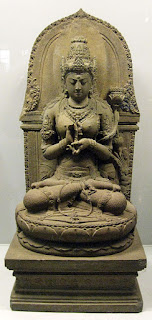The Way of Devotion: Prajñāpāramitā
Prajñāpāramitā, is known as the “Mother of all the Buddhas”. She is always portrayed as female whereas Compassion, by contrast, is generally represented in Indian cosmology as male.
Her name is made up of two words; prajñā, meaning wisdom and referring to the consciousness that can see clearly the true nature of reality, the seeing of the Awakened One or Buddha. The second word is paramita, often translated as ‘perfection’ with the sense of something being ‘beyond’ the ordinary and mundane. The word itself has the connotation of ‘crossing over’, referring to the Buddha’s parable of the raft, in which a man who is trapped on the shore of samsara makes a raft and then paddles himself over to the shore of nirvana on it The image of ‘crossing over’ or ‘moving beyond’ appears again in the Heart of Great Wisdom Sutra (short version), which is chanted in Mahayana temples and which belongs to the literature collectively known as the Prajñāpāramitā literature .
“When the Bodhisattva Avaloketiśvara practised the profound Great Wisdom Gone Beyond he clearly saw that the Five Aggregates are all empty and thus passed beyond suffering.” [1]
This crossing over from one shore to the other is the passing beyond ‘I’, no longer being in thrall to the notion of an enduring and separate self, and is what is meant by seeing the Five Aggregates as empty. This emptiness is, of course, sunyata, the great teaching of the Mahayana, expounded by the Indian sage Nagarjuna (c.150 – c.250 CE) and which is the central theme for all the sutras in the Prajñāpāramitā cycle of sutras.
In this understanding of the deity who is personified as the Wisdom-Gone-Beyond, we have the notion that whether or not Buddhas arise and pass away the Buddha-Heart or Buddha-Mind is ever present. The presence of this Heart/Mind matrix forms the ground of being which gives rise to all phenomena. Thus in one deity we have the basis for the interweaving of phenomena and emptiness which is echoed in the opening lines spoken by Avalokiteśvara:
“Oh Sariputra, form (rupa) is not different from emptiness, emptiness is not different from form. Form is emptiness, emptiness is no different from form. The same applies also to feeling or sensation (vedana), perception (samjna), mental configurations (samskaras) and consciousness (vijñana). ” [1]
These five aggregates are the basis for the arising of all phenomena and are pronounced as being no different from emptiness. Thus, the absolute truth of sunyata and the relative truth of phenomena are not different. The truth is in the everyday world and not outside it.
An ancient story tells that the Buddha realised that the teachings of the Prajñāpāramitā were so profound that humanity was not ready for them. So he gave these teachings to the nagas, mythical snake-beings who live under the ocean. When Nagarjuna was born, he was eventually allowed to enter this realm of the nagas in order to retrieve these teachings and thereafter disseminate them. This reflects another important teaching of Mahayana; that the Buddha taught only according to his audience’s capacity to understand, and no more. This allowed the later teachings their own authenticity and place in the Buddhist lineage.
The mantra associated with Prajñāpāramitā is the one found at the climax of the Heart Sutra:
"Om Gate Gate Paragate Parasamgate Bodhi Svaha"
…
[1] The Daily Devotional Chants of the Zen Centre, pub. The Buddhist Society, London 2008)
............................................
Text copyright to The Zen Gateway
Images:
Prajñāpāramitā statue from East Java, Indonesia... By Gunawan Kartapranata - Own work, CC BY-SA 3.0, https://commons.wikimedia.org/w/index.php?curid=11970401
Prajñāpāramitā personified. From the Aṣṭasāhasrikā Prajñāpāramitā Sūtra... By Asia Society created the file. Artwork created by an anonymous ancient source. - http://asiasocietymuseum.org/region_object.asp?RegionID=1&CountryID=2&ChapterID=10&ObjectID=479, Public Domain, https://commons.wikimedia.org/w/index.php?curid=11580821
Prajñāpāramitā statue from East Java (clothing)... By Gunawan Kartapranata - Own work, CC BY-SA 3.0, https://commons.wikimedia.org/w/index.php?curid=12078947
Naga at the funeral of King Bhumibol Adulyadej of Thailand in 2017... By Z3144228 - Own work, CC BY-SA 4.0, https://commons.wikimedia.org/w/index.php?curid=65033639






Comments
Post a Comment